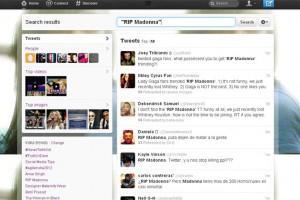Twitter makes lots of things easier, including hoaxes.
Hoaxes aren’t new. We often think of Orson Welles’ “War of the Worlds” broadcast as the standard-bearer for media hoaxes, although that wasn’t intended to be a hoax, just a compelling performance. Nevertheless, nobody likes being a victim of deceit and the flurry of Twitter hoaxes surrounding celebrity deaths is starting to wear thin. This isn’t, of course, the first time that Twitter has been the vehicle for misinformation. Twitter has many benefits: it is a lifeline during crises, a direct line between celebrities and fans, and an open platform for sharing ideas. Twitter also makes it easy to pass along fiction as fact.
 Radio is often described as the most amenable medium to perpetrate hoaxes because it has such broad coverage (we listen to it everywhere in the background) and because the lack of visuals means we use our imaginations more. We might make a similar argument about Twitter, since it has the same portability and lack of visual images; in fact the terseness of the 140 characters leaves much more to be decoded by our agile and creative brains.
Radio is often described as the most amenable medium to perpetrate hoaxes because it has such broad coverage (we listen to it everywhere in the background) and because the lack of visuals means we use our imaginations more. We might make a similar argument about Twitter, since it has the same portability and lack of visual images; in fact the terseness of the 140 characters leaves much more to be decoded by our agile and creative brains.
Hoaxes are a form of deceit or lying, which is, whether we like to admit it or not, common human behavior. Research has shown that children as young as toddlers can understand the value of deceit strategies in interpersonal interactions. We might describe deceit on a socially-constructed value continuum from hyperboles and socially acceptable (aka “white lies”) at one “mostly OK” end to deception and manipulation that causes serious harm at the other.
If information is a source of power and connections are a source of social capital, then a hoax is a manipulation of social power. The costs are significant in terms of lost trust and credibility. In Twitter hoaxes, particularly those about celebrity deaths, the perpetrators are counting upon fans’ emotional attachment to the celebrities to generate an immediate reaction and override a more measured response of healthy skepticism. While a hoax may strike some as funny, and there are undoubtedly some instances of funny ones that we might commonly refer to as ‘practical jokes,’ most hoaxes are designed to promote the psychological or commercial interests of the perpetrator at the expense of the victims. (Remember the boy in the weather balloon ‘crisis’ orchestrated by parents who wanted a reality show?)
Media hoaxes get ‘legs’ because people are biologically wired to attend to unusual or dangerous things in the social environment, thus something like an announcement of the death of an icon has significance to our subconscious brain. It tells us that the world as we know it has changed. It is particularly disturbing when it is someone young because it calls our own mortality into question, beyond whatever cultural or emotional loss we might feel for the person who died.
People also, however, really resent being tricked. (There is even evidence that the impact of researchers who have ‘tricked’ subjects to measure various things is not as benign as they intended.) The fable “the boy who cried wolf” is apropos because if hoaxes are continued, they quickly lose their novelty and raise suspicions and questions of credibility. While the hoax initiators may feel clever and important and relish the reaction to their hoax moving across networks, they are also naive if they believe they will not ultimately be found out or pay the price in some way.
The human being is a social creature and we all need social interaction, feedback and validation of our worth. An emotionally mature person, however, does not do that at the expense of others’ emotional or physical well being. Another negative impact of the Twitter death hoax ‘fad,’ is that the hoaxes take away from the experience of real loss and real events of sorrow. Tweets of ‘Madonna RIP’ occurred during Whitney Houston’s funeral. Disrespect for people we value creates ill will beyond what we feel by being tricked. Behaviors deemed socially unacceptable become fair game for intervention and retribution. In the case of radio and the illustration of the widespread impact of things like “War of the Worlds” broadcast, the FCC enacted a rule against the broadcast of hoaxes that have the potential for public harm aimed at licensees and permittees of broadcast media. In this age of audience content creation, however, the perpetration of hoaxes is also dangerous because it provides fodder for government intervention and regulation at an entirely different level.
Unfortunately for Twitter, part of the fallout is that these celebrity death hoaxes diminish the perception of Tweets as authentic sources of late-breaking information. People will now have to triangulate information from other sources for confirmation. This, while perhaps a bit detrimental to Twitter, is a good thing. Sometimes, obnoxious and thoughtless behaviors serve a positive function. In this case, the hoaxes remind us how easily false information can spread and that it is our responsibility to check it out.
Cross-posted on Psychology Today Positively Media
—–
Photo source: http://ibnlive.in.com/news/really-inspiring-person-twitter-and-the-rip-bug/231519-3.html

